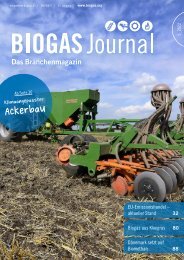Biogas Safety first!
Create successful ePaper yourself
Turn your PDF publications into a flip-book with our unique Google optimized e-Paper software.
Specific requirements
ventilation. Liquid substrates must be fed in through
hoses/pipes in such a way that no gases can escape
into the building. Ventilation systems to/from the
holding tank must end in a safe area via a closed line.
Organisational protective measures
The general principle is that the formation of hazardous
gases outside the feeding system must be prevented
if at all possible, or at least minimised, for example
by preventing certain chemical reactions from
taking place (filling at different times). Mixing of
substrates outside closed tanks from which hazardous
gases such as hydrogen sulphide, carbon dioxide
or ammonia can be formed as a result of chemical
reactions (for instance acid-base reactions) should
be avoided. If reactions are to be expected as a result
of feedstock materials being mixed before they are
fed into the digester, reaction tests should be carried
out with harmless quantities of the substances
before mixing.
Different feeding systems
photos: MT Energie
In order to be able to assess such reactions, operators
of biogas plants must obtain the following
details from the producers of their feedstocks and
document these in the operating diary:
Documentation of details of feedstock materials
main constituents, chemical composition, pH
value and admixtures, e.g. stabilisers, preserving
agents, etc.
details of origin (e.g. from a slaughterhouse, from
the production of heparin in the pharmaceutical
industry, etc.)
transport and delivery conditions (e.g., duration
of transport, temperature, ...)
potential hazards (e.g. ‘can release hydrogen
sulphide upon addition of acids’). If it is impossible
to rule out the formation of hazardous
gases, especially H 2
S, it is necessary to prevent
or reduce their release, for example by means of
closed filling, spatial separation or forced removal
of the gases.
other remarks
Materials with a high sulphur content include wastes
from slaughterhouses, waste biomass (mycelium)
from biotechnological processes, rapeseed cake,
remnants of animal feed (e.g. soy protein), methionine
from animal feed (feed additive), residues from
yeast production, sodium sulphate as a preserving
agent, adjuvants such as iron sulphate or catering
waste.
Feeders may need to be fitted with a control platform
to ensure that the filling or flushing hose is safely
controlled. Attention must be drawn to the gas hazards
in the immediate proximity of the feeder. If the
occurrence of gases in hazardous concentrations in
feeding areas cannot be ruled out, suitable gas warning
equipment must be installed to ensure that warning
is given of gas hazards, in particular from H 2
S.
In the course of their work on feeders, employees may
be exposed to biological agents through contact with
substrate, fermentation products or condensate or
with impurities in pipes and gas-carrying plant parts.
The number of employees who are or may be exposed
to biological agents must be limited to those actually
needed to perform the task in hand. Before carrying
out work in the danger area of feeding systems, check
whether the work is permitted to be performed alone.
In particular it is important to be certain of preventing
the feeding systems from starting up automatically
during maintenance work.
During the filling process, trace elements (e.g. nickel,
selenium) are often added to the feedstock. As a general
rule the use of trace elements should be restricted
to the necessary minimum. If the use of additives
and auxiliary materials is unavoidable, zero-emission
or low-emission types must be chosen (e.g. pelleted
32


















